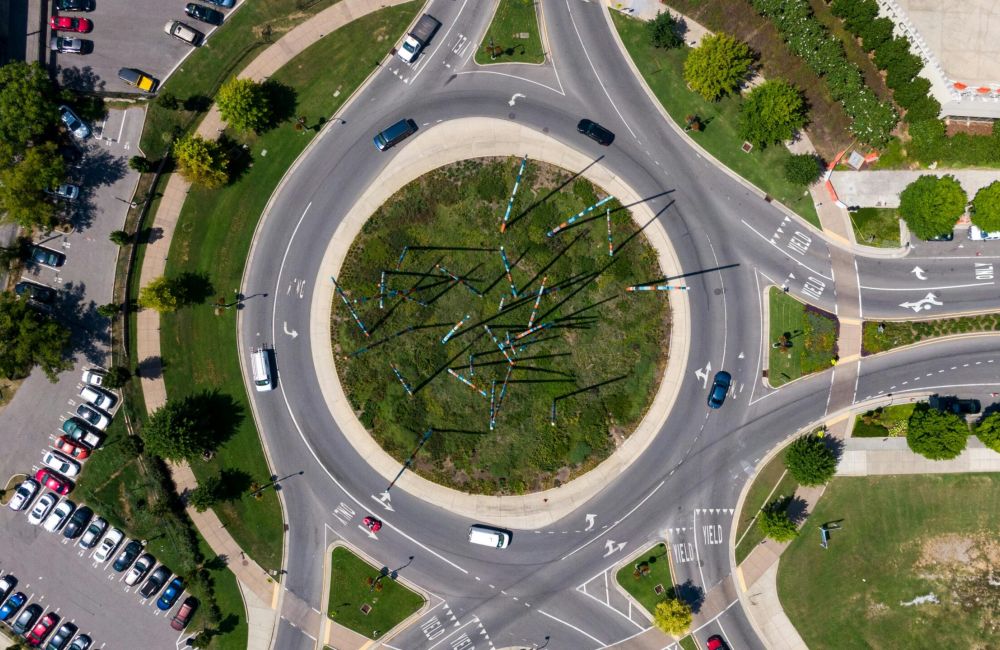Roundabouts are becoming more and more popular in the U.S. due to their added benefits, and across New York State, there are approximately 250 roundabouts. Their implementation has dramatically reduced serious injury and fatality crashes, and also has had a positive impact on traffic flow and overall driving awareness.
Since roundabouts are on the rise, it’s important for drivers to understand and know how to safely navigate the next roundabout that comes up.
Why are roundabouts taking over the classic four-way-stop intersections?
Intersections are a national safety concern because they make up approximately 75% of annual traffic-related fatalities and injuries in the United States.
Taking into consideration the location of an intersection, studies have shown that roundabouts increase the efficiency of intersections anywhere from 19% to 90%. Unlike traditional intersections, roundabouts promote a continuous flow of traffic. With no traffic signals or stop signs, the circular and constant movement of traffic ultimately reduces the risk of very common accidents. For example, the smooth design of the entry and exit points is intended to reduce rear-end collisions, the one directional traffic pattern prevents T-bone collisions, and the slower nature of navigating the circle decreases the chances of high-speed collisions. Combining all of these factors promotes a safer driving environment.
In terms of pedestrian safety, the overall design of a roundabout can help promote a clear path for walkers, runners, and others to navigate. Not only are motorists required to slow down, but clearly marked crosswalks on each cross-section of the circle makes it obvious to drivers where they should expect people to cross. Crosswalks also guide pedestrians to the safest route across. In addition, some roundabouts have a center island which breaks up the crosswalk and encourages pedestrians to assess the traffic flow before crossing. These features reduce vehicle/pedestrian interaction and permit pedestrians to cross traffic that’s coming from only one direction. This improves the overall safety dynamic for everyone on the road.
Roundabouts are only considered safer and more efficient if there’s a collective understanding among drivers about how to properly navigate them. Let’s discuss this in greater detail.
How do you safely navigate a roundabout?
As you approach a roundabout, reduce your speed and yield to oncoming traffic, pedestrians, and, if necessary, bicyclists in their designated lanes in the roundabout.
Who has the right of way?
Circulating traffic always has the right of way. This means drivers entering the roundabout should always yield to the traffic that’s already in the roundabout.
Depending on the size and location of the roundabout, there might be more than one lane, so you should pay attention to signs that will indicate which lane to be in based on your exit.
What’s the safest way through a roundabout?
Once in the roundabout, maintain a steady speed, following speed limit postings and stay aware of surrounding vehicles to limit unnecessary accelerating or braking.
Once you’ve reached your intended exit, signal your intentions, follow the lane, and merge out of the roundabout. This ensures a smooth departure for you and encourages caution in drivers behind you.
What should I do if I’m ever injured in a roundabout motor vehicle crash?
If you or someone you know is injured in a Buffalo area motor vehicle crash, it is crucial to take immediate and appropriate action. Despite the safety measures implemented in roundabouts, and on roads in general, crashes unfortunately still happen.
The aftermath of an injury crash can be overwhelming and confusing, so here are some general steps you can follow in the event of a crash:
- Always remember – Safety First: Get all individuals to a safe space, if you can – in other words, get out of the road;
- Assess injuries and damages, and attend to your injuries first;
- Contact 911 immediately – police investigation and obtaining a police report are critical;
- If you can safely do so, document the accident by taking photos;
- Receive proper treatment, if necessary; and
- Contact us at 716.839.9700 because there are short timelines associated with motor vehicle accidents, and we can help.
Our team at The Coppola Firm is experienced when it comes to personal injuries resulting from driving or riding in a car. If you’re ever injured in a motor vehicle crash that is not your fault, roundabout related or not, contact The Coppola Firm at (716) 839-9700 or info@coppolalegal.com. We’re here to help.

